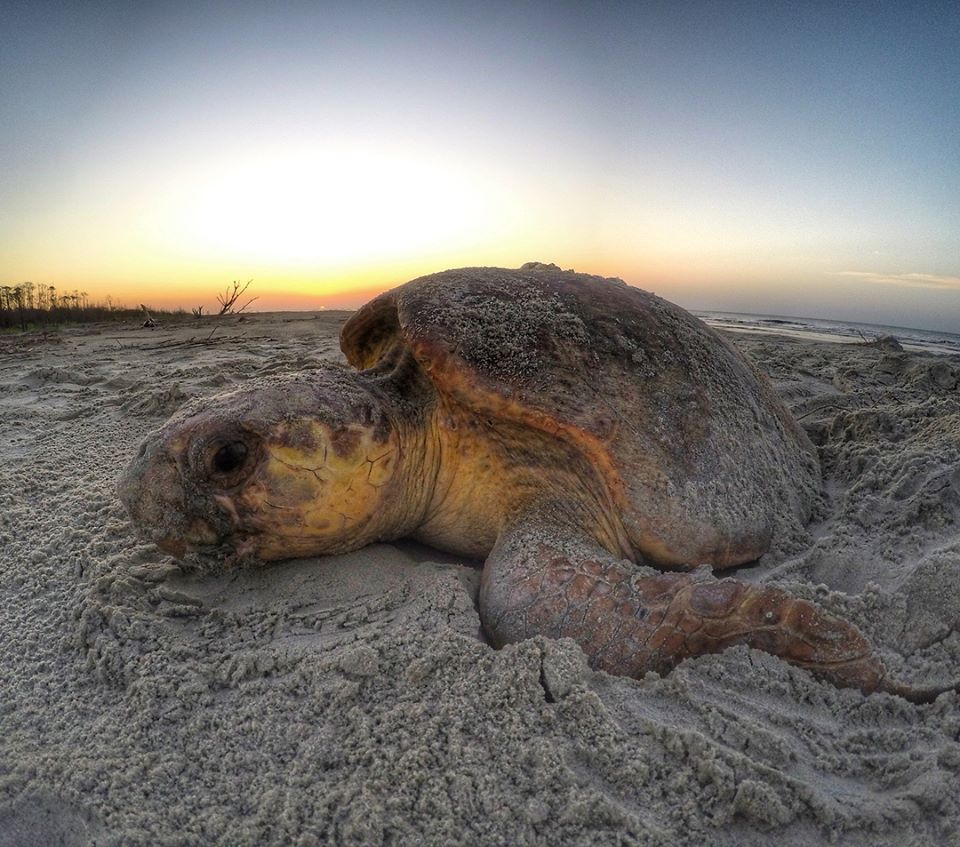It isn’t just vacationers and sun worshippers who are heading to the beach. Beginning late spring and throughout the summer, female sea turtles are drawn to the shore, too, making their way onto the sand to lay their eggs. And so far, for loggerheads along the Southeastern coast, it’s shaping up to be a banner year. The nesting season, which began in May and lasts as late as October, has already seen an unprecedented number of nests since researchers began widely monitoring them in the late ‘70s. That means, if all goes according to plan, an unprecedented number of hatchlings will be crawling to the ocean beginning in July.

Photo: courtesy of Caretta Research Project
Hatchlings crawling to the ocean.
Loggerhead turtles (scientifically known as Caretta caretta), one of seven species of sea turtles on the planet and the most prevalent species in the South, have been listed as “threatened” since 1978. An individual adult female crawls onto a beach every two to three years, where she digs a hole with her flippers and lays upward of a hundred eggs at a time before covering the chamber back up with sand. Sixty days later, those hatchlings will break from their shells and crawl toward the ocean.
Along with the coast of Oman in the Middle East, the shores of South Florida’s Atlantic coast are the most densely populated areas for loggerhead nests anywhere in the world. Based in Juno Beach, the Loggerhead Marinelife Center presides over 9.5 miles of shoreline encompassing Juno, Jupiter-Carlin, and Tequesta beaches. While last year was a slow year, with 10,977 loggerhead nests on their shore, already in 2019— not even halfway through the season—7,757 nests have been counted(at time of publication). “We’re on pace to be over 20,000 this year,” says Tom Longo, the center’s associate director. “That’s a record for loggerheads.”

Photo: courtesy of Caretta Research Project
A hatchling at Wassaw National Wildlife Refuge.
Another hot spot for loggerheads is the Cape Romain National Wildlife Refuge near McClellanville, South Carolina, a preserve that sees more loggerhead nests than anywhere on the East Coast outside of Florida. While they also had a slow year last year, with volunteers counting about 1,000 turtle nests, this year is shaping up to be a record breaker there, too. “Turtles nest cyclically,” says Chris Crolley, who runs Coastal Expeditions, a company that provides ecologically focused trips through South Carolina’s Lowcountry habitats, working closely with and raising funds for places such as Cape Romain. “The biggest year on record was 2017, with 2,500 or more nests. Nobody had seen that before. This year, the frequency is so much higher that we’ve eclipsed what happened totally last year, and we’re on track to beat 2017.”
Crolley and other observers say the surge may be evidence that conservation efforts put in place decades ago are paying long-term dividends. “It takes about twenty-five to thirty-five years for a sea turtle to reach sexual maturity,” Crolley says. “Guess how many years people have been protecting sea turtle nests now?”

Photo: courtesy of Caretta Research Project
A nesting loggerhead in Georgia.
Indeed, for a little over three decades, employees and volunteers with Department of Natural Resources offices, the U.S. Fish and Wildlife Service, and other entities have been working to locate nests on beaches where they don’t stand as good a chance, whether from full and new moon tides or human interference, and move them to safer nesting sites. “Other times, turtles put their nests in good spots to begin with,” Crolley says. “So we just take measures to keep racoons and coyotes out.”
Kris Williams, the project director at the Caretta Research Project, a program dedicated to protecting loggerheads on the Wassaw National Wildlife Refuge near Savannah, Georgia, has also seen a big surge in nesting turtles this year and agrees those efforts have had an impact. “At Wassaw, this is our forty-seventh year protecting nests, and the entire coast has been protecting nests since 1989,” she says. “So we’re finally seeing the results.”
Of course, the spike in nest numbers can’t be chalked up to just one factor. Experts also cite turtle excluder devices, which allow loggerheads to escape fishing nets and became federally mandated for all commercial shrimp boats in 1987. In addition, “Lights Out” initiatives have helped curb light pollution on beaches, which can inhibit adult turtles from nesting and disorient hatchlings.

Photo: Katie Doherty
A hatchling at Cape Romain.
So are Loggerheads now well on their way to crawling off the threatened species list?
“Not soon,” Williams cautions. “There are still a lot of threats they face: beach development, storm activity, beach erosion, increased beach temperatures, increase in marine debris. All these things have the potential to harm sea turtles.”
As sea turtle numbers increase, it also poses new problems for the turtles and the people who study them. Florida’s Loggerhead Marinelife Center, for instance, operates primarily as a sea turtle hospital. “With those increased numbers, we’re also seeing a lot more boat strike injuries,” Longo says. “We’re trying to spread awareness to boaters and anyone else out on the water to look twice for turtles.”
Another concern for the future: Sea turtles are subject to temperature-dependent sex determination. In warmer temperatures, turtle eggs are more likely to hatch into females, while cooler temperatures are more likely to incubate males. “Rising beach temperatures could lead to a lot more girl turtles,” Crolley says. “Plus, rising water levels will destroy nesting habitats. Where will they go? It’s a mystery.”
So while this year’s numbers are good news, it remains to be seen whether the trend will continue, and experts caution that it’s as important as ever to remain vigilant. “A major keystone to this is funding,” Crolley says. “The lifeblood of Cape Romain is our volunteer effort. We need help figuring out how to prepare for this new era of stewardship.”








